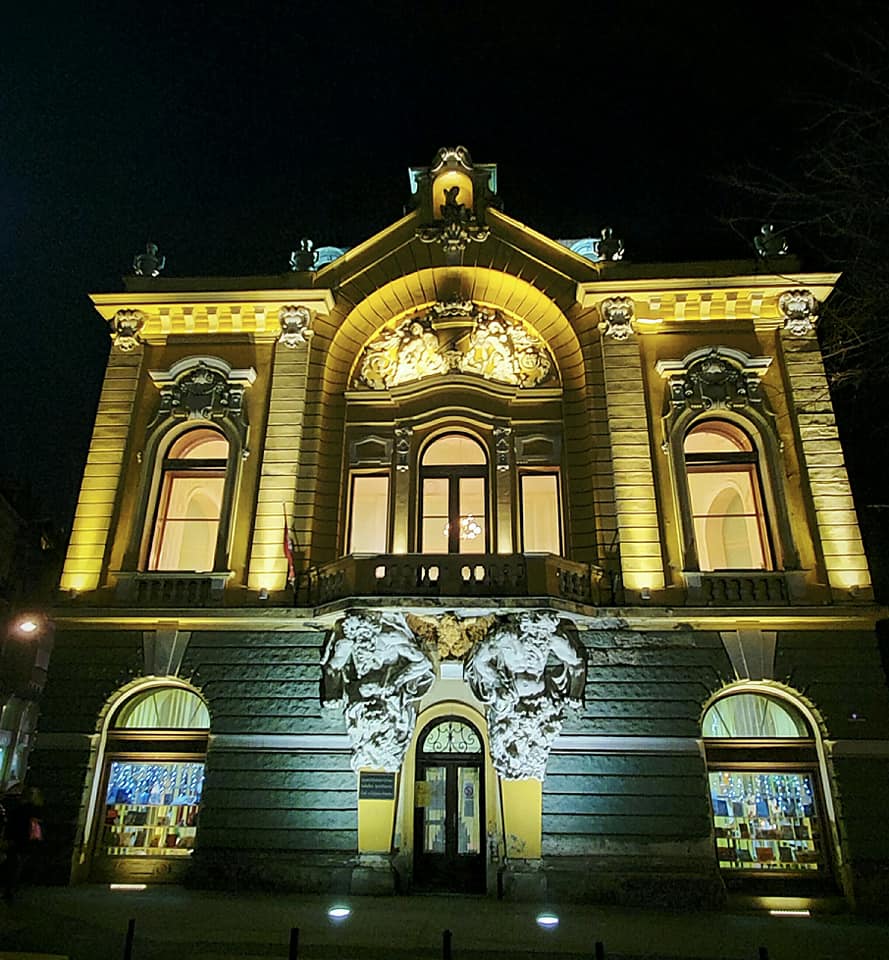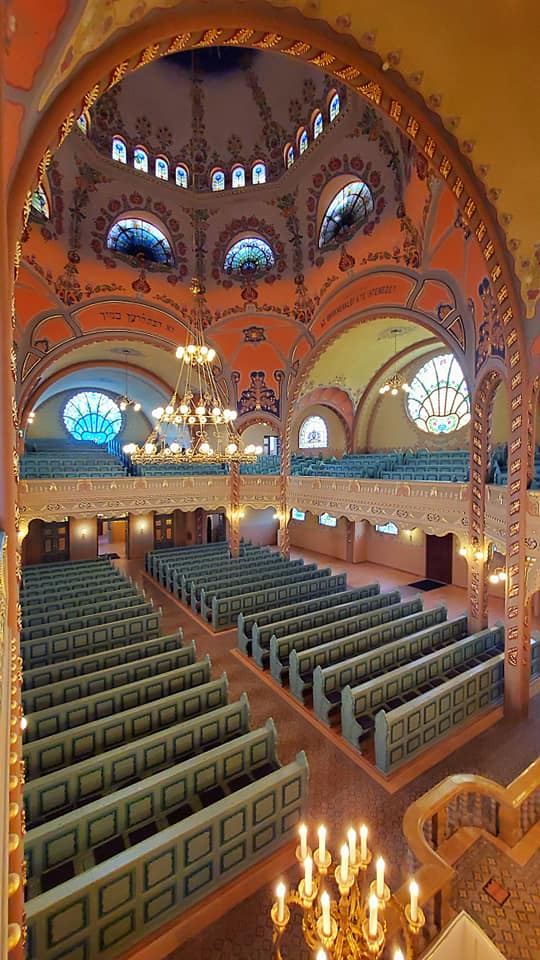I felt depression beginning to descend upon me as I neared the end of developing my itinerary for the lost cities beyond Hungary’s borders. By the time I reached the final city, Subotica in northern Serbia, I should have been suffering full blown sadness. Instead, I began to feel radiant. Subotica can do that to me. My first visit to the city took place four years ago and it was spectacular. A bright winter day, cool and crisp beneath a sky that could not have been bluer. Subotica’s architecture matched the rays of light that shined down upon it. The City Hall was one of the most impressive buildings I have ever seen and that was without stepping inside. Subotica gave me everything and left me wanting more.

Lighting ceremony – Splendor in Subotica
Now Playing – City Of Survival
Sometimes for your own sanity, you need to let things go. Loved ones you have lost, first loves that faded, other romances that failed, human and otherwise. Love usually comes and goes. It is like a secret that gets passed around. Once in a great while, true love stays with you. And so it is with the lost cities. They continue to occupy my imagination. Perhaps that is because of the inherent drama in their history since the late nineteenth century. Any one of the lost cities would make a great play. My final stop in Subotica is grand theater. There are multiple acts (Austria-Hungary, Kingdom of Yugoslavia, wartime Hungary, communist Yugoslavia, Serbia), heroes (Art Nouveau architects) and villains (communists, fascists, and nationalists), romance (not just for individuals, but for the entire city) and tragedy (World Wars I and II, Treaty of Trianon, the Holocaust) suffering and loss (ethnic Hungarians, Jews, other minorities), survival and resurrection (the city center, synagogue). All the ingredients are there for tragedy and triumph.
Various iterations of the play have been running for over a century to dramatic effect. There are matinees and midnight showings. The current version features Subotica’s survival and resurrection. Art Nouveau architecture plays the leading role. The performance does not disappoint. The play opens with the main protagonist seeing the Raichle Palace just after arrival at the train station. The decorative floral patterns on the building are in full bloom. That opening catches the viewer’s attention, Subotica Synagogue captures it. The superlatives to describe this scene have not yet been invented. The play unfolds from there throughout the city center. Reviews fail to do it justice, but the scribes still try. I located the following review deep in my imagination:
The Subotica Synagogue is the closest thing to magic. For those who have trouble believing in God, seeing the fully restored synagogue will prove to be a revelation. Its architecture and aesthetics, symmetry and spirituality are inspired by a higher power. Eternity is preserved within those hallowed walls. The synagogue proves to be as astonishing as the history of the people who worshiped there is tragic. Nothing in the viewer’s experience can prepare them for such a setting,
Subotica’s survival is the counterpoint to all the hurt, all the anger, all the pain, that fell on this little corner of Eastern Europe after the First World War. The city suffers grievous wounds for many decades, but the cityscape survives as an expression of human creativity and ingenuity. Its most stunning pieces of architecture represent the highest levels of artistic achievement. For the play’s protagonist, Subotica’s city center is a stand in for all that is worth saving in the world. He finally realizes that he has entered the magic kingdom. The spiritual force of the structures is so real that the viewer, like the protagonist, can feel them. The hand of God which designed, crafted, and sculpted Subotica reaches out to touch the audience.
Heavenly ascent – Inside Subotica Synagogue
Transcendent Beauty – Desperate Tragedy
Subotica is an endless reel, a succession of spectacular images that keep playing in my head. Do all good things have to end? Maybe not since Subotica and all the other lost cities are still standing. The itinerary I developed will end, but the lost cities will go on. Someone, somewhere, right now is rediscovering them. They are seeing something of themselves in the transcendent beauty and desperate tragedy that stalks their squares and streets. The greatest discovery I made while developing my itinerary is that in the lost cities, I see the best and worst aspects of myself. In Eisenstadt, my frivolity is represented by the candy-colored Esterhazy Palace. In Bratislava’s Old Town, the walls I have built around myself to keep the rest of the world out. In Kosice’s towering St. Elisabeth’s Cathedral, a dream I will never reach. In Uzhhorod, the place where I fear to go. In Oradea, the best version of myself. În Timișoara, my ingratitude for the gift of life after the apocalypse. In Subotica, my belief that life is everlasting.
Each lost city feels like the first and last day on earth. I am sure many of those who suffered and survived in them felt the same. The Austro-Hungarian Empire could be just as bright and beautiful as those who built it. The empire could also be just as dark and decadent as those who destroyed it. All empires vanish, not a single one has managed to survive. That stark fact should be just as humbling to us as Austria-Hungary’s collapse was to its inhabitants. The true measure of an empire is not in its ascension and apex, nor in its decline and fall. The true measure of an empire is its legacy. What it leaves behind for others to build upon, to aspire, to protect, and preserve. In that regard, the legacy of Austria-Hungary is well served by the lost cities. There is still life in those ruins.

Lighting up the night – Subotica’s City Hall
Imperial Ways – Life Lessons
The lost cities are astonishing storehouses of art, architecture, and culture. They teach us lessons in history from which we can learn. They show how to prosper during good times and endure when all hope seems lost. They demonstrate the ability to bask in past glories, while stepping boldly into the future. They tell us to enjoy what we have because one day it will be gone. They demonstrate that nothing is inevitable, even if it seems that way.
Click here for: Obstacle Course – Navigating Trianon (The Lost Cities #13)


It’s so strange because I was just looking at old brochures of the Simplon-Orient-Express and Taurus Express through to Baghdad a few weeks ago and noticed Subotica on the brochure. I wondered why I had never heard of Subotica before and at the same time thinking it sounded like a Kraftwerk song and now, here you are, writing about the very same place!
Ah Kraftwerk and Trans-Europe Express;)
The version that went through Subotica:
In the 1930s the Orient Express itself (as opposed to the Simplon Orient Express) ran three times a week from Paris Gare de l’Est – Munich – Vienna – Budapest – Belgrade – Istanbul.
It is interesting how the Orient Express has such a refined air of sophistication. The first journey was anything but that. They could not go through Thracian Turkey because of banditry and rampant lawlessness. Who could blame them. In 378, Emperor Valens got burnt up in a cottage by the Goths at Adrianople (Edirne). Nothing much had changed. And then there was Bulgaria:
It sounds to me that it was then that two eras were clashing headlong into each other, the ancient East and the industrial West. How fascinating!
https://retours.eu/en/51-taurus-express-iraq-egypt/#:~:text=From%20London%20and%20Paris%20to,but%20was%20not%20yet%20finished.
Good webpage. I visisted Haydarpasa Station in 2013. It was then under restoration It looked like it was all dressed up with nowhere to go. Beautiful and lonely
I hope to visit some of those stations one day, Haydarpasa sounds like a dream, an old ocean liner marooned on a sand bank.
Very well said. The station is the equivalent of a person who looks like they were born at a certain time and never aged. Most of the 20th and 21st centuries have never never existed at Haydarpasa. It is always 1908.
This is really good and McMeekin does great work: https://www.amazon.co.uk/dp/0141047658?ref_=cm_sw_r_apan_dp_DT2HXD2M4GMH6SZYHA8A&language=en-GB
It looks like an amazing book, i’ll check it out.
They also have an interesting page on that website about Yugoslavia you might like.